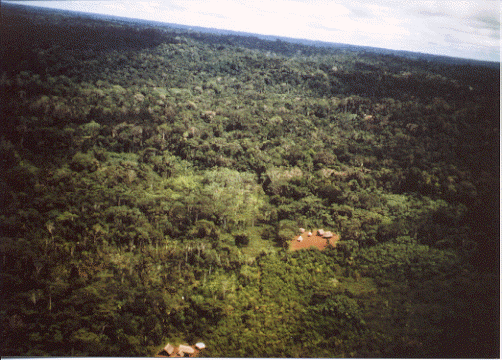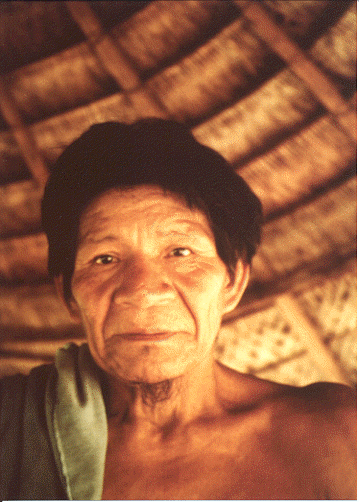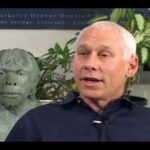Lawrence S. Sugiyama, John Tooby, and Leda Cosmides
We chose as our study population the Shiwiar of Ecuadorian Amazonia, a group of hunter-horticulturalists whose way of life was as different from life in industrialized societies as any that presently exists, and one that in several key respects more closely reflects the kind of social environment in which humans evolved. The focus of research was to test whether the Shiwiar would exhibit the same subtle patterns of reasoning as all other tested populations do, despite major differences in cultural, social, and physical environments.
These photos are from the study site in the rainforest of the Ecuadorian Amazon. One is a a Shiwiar man, and the othertwo are aerial views of Shiwiar villages — the clearings encircled by rainforest.

Shiwiar live in a remote area, and have little direct contact with outsiders. What contact they have is possible primarily via missionary emergency medical airlift on small dirt airstrips cut in the forest with machetes and axes. These flights typically do not enter a given village for months on end and in smaller villages may not be made for periods as long as a year. Missionaries are not resident in study villages and Shiwiar leaders prohibit the presence of most outsiders.
This Shiwiar man is standing in his jean (hay’-an, his house).

Shiwiar in the study area have no everyday direct contact with outsiders. The rivers the Shiwiar live along become unnavigable long before they reach the frontiers of colonization, and there are no roads. They depend on hunting (often with blowguns), fishing, gardening, and foraging for their livelihood. Relatively few Shiwiar speak Spanish, and Shiwiar, a non-Indo-European language, is the language of daily life. Traditional ties of kinship and affinity dominate social relationships mediated by gossip, witchcraft, and the threat or use of violence, and the Shiwiar continue to interpret the world through a culturally distinctive worldview. Although it is impossible now to find a group of people who are not subject to some influence from the industrialized world, Shiwiar in the study villages are at the far end of this spectrum. To the extent that they have been influenced by the outside world, it has been largely a material influence, such as the gradual adoption of some nonindigenous crops, and the acquisition of various tools and artifacts.

These experiments were administered by Larry Sugiyama in 1994-1995. The description above refers to life among the Shiwiar at the time of the study. Of course, things have changed a bit among the Shiwiar since then, due to increasing oil exploration near the edges of their territory.






